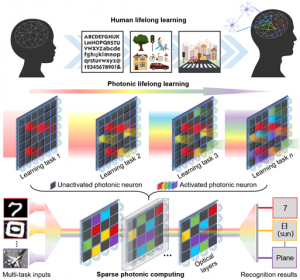Photonic neuromorphic architecture for tens-of-task lifelong learning
USA, April 3, 2024 /EINPresswire.com/ -- Endowed with the superior computing efficiency, optical neural networks (ONNs2) have shown great potential in complex visual processing. To realize the magic power of ONNs, scientists recently developed L2ONN (Lifelong-Learning Optical Neural Network) based on a reconfigurable sparse photonic computing framework, realizing real-world incremental multi-task learning optically. Breaking the capacity and scalability limitations of both conventional ONNs and ANNs, the proposed technique permits terminal/edge AI systems with light-speed efficiency and unprecedented scalability.
Artificial intelligence (AI) tasks become increasingly abundant and complex fueled by large-scale datasets. With the plateau of Moore’s law and end of Dennard scaling, energy consumption becomes a major barrier to more widespread applications of today's heavy electronic deep neural models, especially in terminal/edge systems. The community is imminently looking for next-generation computing modalities to break through the physical constraints of electronics-based implementations of artificial neural networks (ANNs).
Photonic computing has been promised to overcome the inherent limitations of electronics and improve energy efficiency, processing speed and computational throughput by orders of magnitude. Such extraordinary properties have been exploited to construct application-specific optical architectures for solving fundamental mathematical and signal processing problems with performances far beyond those of existing electronic processors.
Unfortunately, existing ONNs suffer ‘catastrophic forgetting’ thus are still struggling with simple onefold tasks. The main reason is that they inherit the widespread problem of conventional computing systems, which are prone to train new models interfering with formerly learned knowledges, rapidly forget the expertise on previously learned tasks when trained on something new. Such an approach fails to fully exploit the intrinsic properties in sparsity and parallelism of wave optics for photonic computing, which ultimately results in poor network capacity and scalability for multi-task learning.
In a recent paper (https://doi.org/10.1038/s41377-024-01395-41) published in Light Science & Applications, a team of scientists, led by Professor Lu Fang from Sigma Laboratory, Department of Electronic Engineering, Tsinghua University, Beijing, China, and co-workers have developed L2ONN, a reconfigurable photonic computing architecture for lifelong learning. The unique characteristics of light, spatial sparsity and multi-spectrum parallelism are developed in photonic computing architecture for the first time, endow ONNs with lifelong learning capability. Unlike existing ONNs trying to imitate ANN structures, the photonic lifelong learning of L2ONN is initially designed following the physical nature of light-matter interaction, to fully explore the functional and performance potentials of wave optics in photonic computing.
Benefiting from the proposed lifelong-learning optical computing architecture, experimental evaluations on free-space and on-chip architectures demonstrate that L2ONN shows its extraordinary learning capability on challenging tens-of-tasks, such as vision classification, voice recognition and medical diagnosis, supporting various new environments. L2ONN achieves up to 14× larger capacity than existing optical neural networks, while an order of magnitude higher energy efficiency than the representative electronic artificial neural networks.
These scientists summarized and emphasized the innovations of their novel optical computing architecture:
‘Humans possess the unique ability to incrementally absorb, learn and memorize knowledge. In particular, neurons and synapses perform work only when there are tasks to deal with, in which two important mechanisms participate: sparse neuron connectivity and parallelly task-driven neurocognition, together contribute to a lifelong memory consolidation and retrieval. Accordingly, in ONNs, these characteristic features can be naturally promoted from biological neurons to photonic neurons based on the intrinsic sparsity and parallelism properties of optical operators.’
‘An optical architecture imitating the structure and function of human brains demonstrates its potential to alleviate the aforementioned issues, which shows more advantages than electronic approaches in constructing a viable lifelong learning computing system. We have demonstrated the photonic lifelong learning provides a turnkey solution for large-scale real-life AI applications with unprecedented scalability and versatility. We anticipate that the proposed neuromorphic architecture will accelerate the development of more powerful photonic computing as critical support for modern advanced machine intelligence and towards beginning a new era of AI.’ the scientists added and forecasted.
DOI
10.1038/s41377-024-01395-4
Original Source URL
https://doi.org/10.1038/s41377-024-01395-41
Funding information
This work is supported in part by Natural Science Foundation of China (NSFC) under contracts No. 62205176, 62125106, 61860206003, 62088102 and 62271283, in part by Ministry of Science and Technology of China under contract No. 2021ZD0109901.
Lucy Wang
BioDesign Research
email us here
1 https://doi.org/10.1038/s41377-024-01395-4
2 https://doi.org/10.1038/s41377-024-01395-4

